Score breakdown
Things we like
- Cross-country pace
- Taycan pace on a Macan budget
- Well-judged sporty ride
- Futuristic appearance
Not so much
- Expensive servicing for an EV
- Restricted real-world driving range
- Fast EVs are a little one-dimensional
Alex Affat was suitably impressed at the Kia EV6 GT’s Australian media launch. The program took in some of Victoria’s most testing roads and a stint at Haunted Hills raceway – a tight and technical hillclimb course around which Affat relished throwing the two-tonne Kia.
“Kia’s EV6 GT is a supremely talented thing, and if dynamic driving forms part of your remit, this car will do things even its talented siblings can’t, and that’s a lot,” Affat remarked.
A track day is a pretty good way to make a performance-focused $100K Kia shine, but what’s this car like to live with in more regular driving? And is that firm adaptive suspension too stiff for Sydney’s particularly vicious roads?
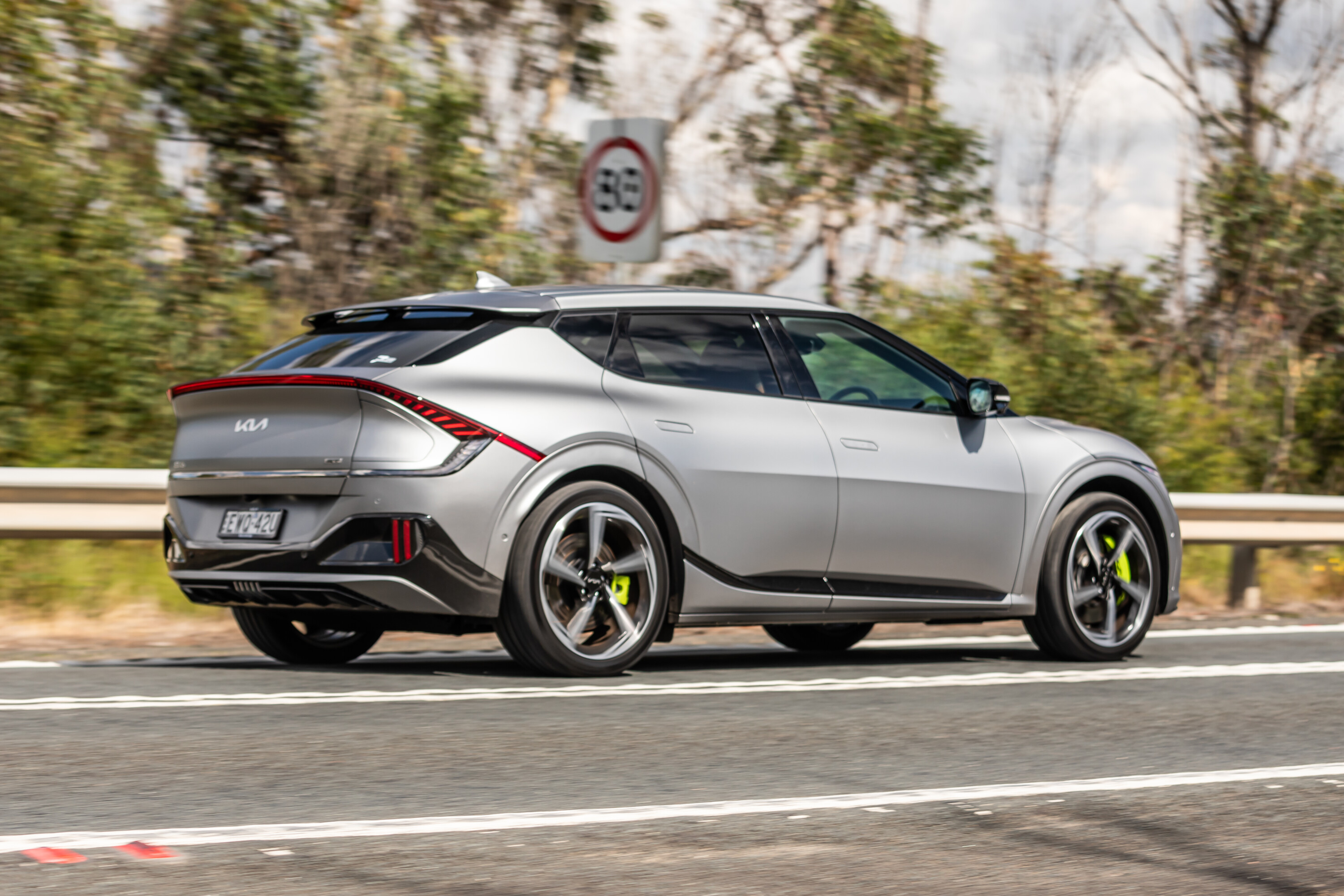
Spoilers here, but the EV6 GT is a superb machine. And, providing you’re aware of what you’ve gotten yourself into, you’ll find the suspension is immaculately judged. We even sat down with chassis dynamicist Graeme Gambold to really understand the magic in the EV6 GT’s ride/handling balance.
Perhaps most importantly, this road drive is about understanding how much damage upping the GT’s power and grip levels has had on the real-world driving range.

JUMP AHEAD
- How much is it, and what do you get?
- How do rivals compare on value?
- Interior comfort, space and storage
- What is it like to drive?
- How much energy does it use?
- How safe is it?
- Warranty and running costs
- VERDICT
- Specifications
How much is it, and what do you get?
The GT is Kia’s flagship EV6, but as in certain other performance brands (Hyundai N, BMW M, Porsche RS), you often pay more for less.
In this instance, the best example is that, for $12,000 more, you swap the GT-Line’s plush, leather-appointed, heated, cooled, and electrically-adjustable seats for a pair of lightweight manual-adjust buckets. For some, this will be a problem, and if it is I’d heartily recommend sticking to the GT-Line.
For me? I love the bucket seats, they’re figure-hugging and feature fine manual adjustment that allows an excellent driving position.

| Kia EV6 GT features | |
|---|---|
| 21-inch alloy wheels | Matrix LED headlights |
| Suede-cloth manual-adjust seats | Wired Android Auto/Apple CarPlay |
| Seat heating | 12.3-inch touchscreen |
| 12.3-inch digital driveru2019s display | Wireless smartphone charging |
| 14-speaker Meridian sound system | Gloss black interior trim |
| Dual-zone climate control | Augmented reality HUD |

How do rivals compare on value?
If you’re chasing an electric car that gets to 100km/h in a similar amount of time, you’re well served… providing the bank will loan you upwards of $200,000 for a Porsche Taycan Turbo.
As for options closer to $100K, well, it’s pretty much just Tesla’s Model 3 and Model Y Performance, and the Kia has already dispatched the Y in a previous twin test.
Much of the discourse around electric cars returns to driving range, though, and that’s something at which the EV6 GT doesn’t excel. The Model Y Long Range AWD has 533km WLTP driving range, and the regular EV6 GT-Line AWD is rated at 484km (WLTP).

Interior comfort, space and storage
There’s a lot of chatter that electric vehicles are all the same; well I’m here to tell you that from the driver’s seat, they aren’t.
A Tesla Model Y is minimal (to a fault), the Ioniq 5 is airy and Jetsons-esque, and the Polestar 2’s cabin feels like a Swedish audiophile’s listening room.
The EV6 GT, though, is like stepping into an 80s arcade. In a good way. Long, sharp lines and vivid ambient lighting lift what is a cocooning cabin. It’s divided opinion among our testers, but some will love the consistent fluorescent chartreuse accents that carry from the brake calipers to the stitching, optional ambient lighting colour, and wheel-mounted GT button.
On the subject of the two-spoke steering wheel, it’s unorthodox, but not in a bad way. Any early worries of forgetting which way up it is don’t materialise in practice. Along with the GT Mode button, there’s a drive mode selector and controls to interact with the 12.3-inch digital driver’s display.

A 12.3-inch touchscreen is angled towards the driver, though the top left corner is quite a reach. The software is attractive and easy to use but doesn’t offer the outright power of Tesla or Polestar’s software. Navigation with live traffic is included, and the Apple CarPlay/Android Auto connection is wired.
Material quality is generally high, the GT-Line and GT are big steps over the plasticky EV6 Air, and both are worth the premium. Though at $100K, the EV6 GT’s hard plastic rear door cards aren’t good enough. Build quality seemed solid out on the road with no creaks or rattles noted.
For storing odds and ends, the EV6 GT is great (aside from the tight door cards), with a huge space below the floating centre console perfect for small bags, tissue boxes, or sick bags (you might need them with this much grunt). There are two cup holders and a covered centre cubby with a wireless charging pad that securely holds phones.
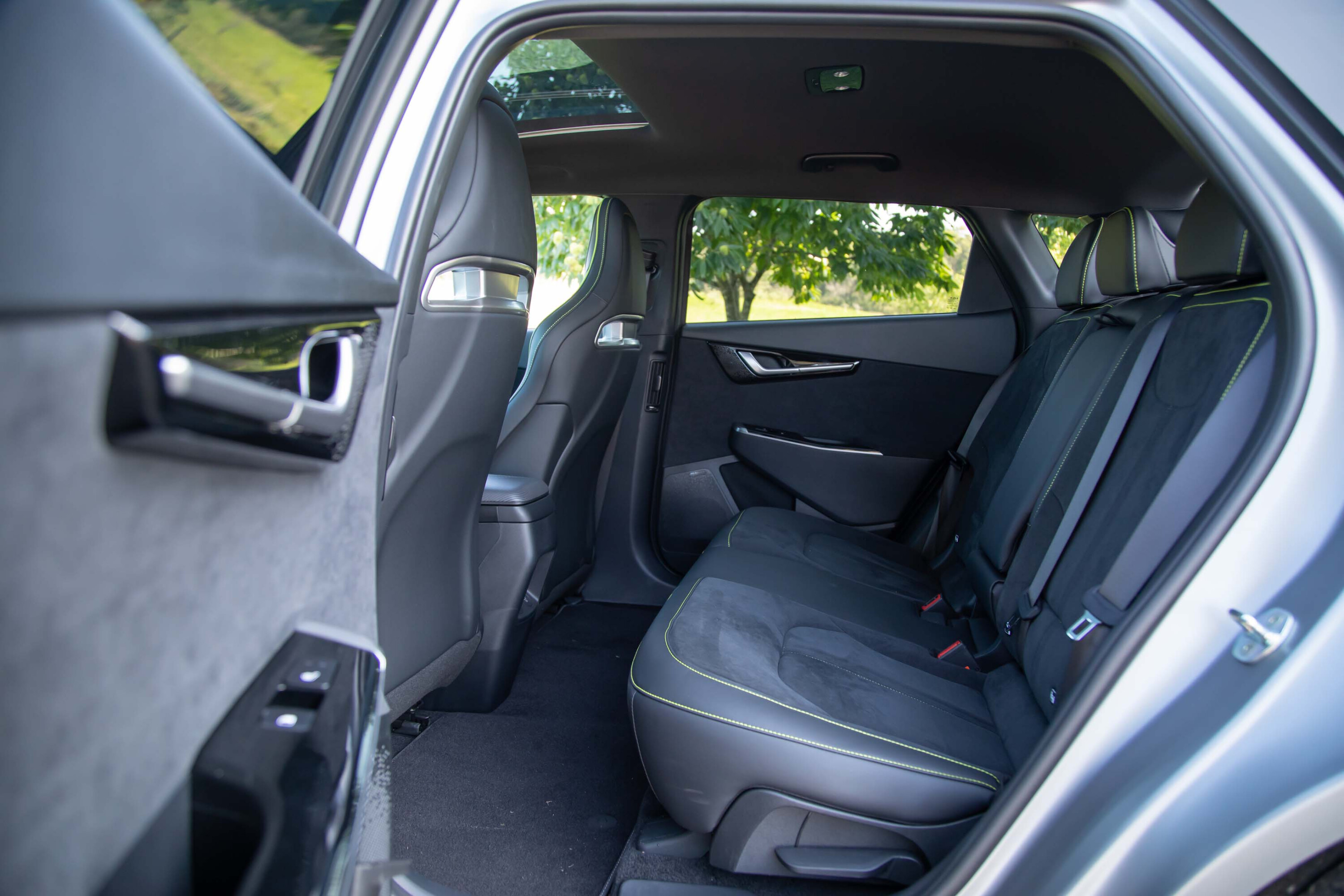
Then there are the seats that, yes, are suedecloth clad and manually adjustable, but for more slender drivers they’re ace with great support and, although they initially lack padding, I never once got a sore back driving the EV6 GT.
Being slimmer and set lower than the standard EV6 chairs, the GT buckets also improve the EV6’s rear quarters as they are easier for passengers to see past and over. They’ve also got slimmer backrests to liberate more legroom, not that the spacious EV6 really needed it.
Roomy as the EV6’s rear seat is, the black headliner, tinted privacy glass and small sunroof make it quite dark. The sporty seating arrangement sees the outer two spots scalloped to hold in passengers, but it leaves a hump in the centre position, so three across is only comfortable on short journeys.

A Model Y’s rear quarters are more spacious but no more comfortable.
The EV6 GT maintains rear air vents in the B-pillars, a fold-down armrest, a reclining backrest, and two USB-C ports. There’s also a three-pin socket inside for vehicle-to-load functionality – charging laptops, for example – and an optional adapter that connects to the Type 2 charge port to power camp stoves, fridges, and other larger appliances.
Under a standard power tailgate, the EV6 hides a 480L cargo space. It’s reasonable, but not huge given the size of the vehicle, and there’s only a can of goo to fix a flat tyre. It’s got a small ‘frunk’ (20L) that’s OK for charging cables and other bits but isn’t big enough for luggage. Folding the seats flat using the pull tabs opens up 1260L cargo space.

What is it like to drive?
The E-GMP bones of the COTY-winning EV6 are stellar, but until this GT, the platform’s potential hadn’t been fully unlocked.
It’s likely that the Ioniq 5 N will come and move the outright grip and focus game on further, but as a grand tourer (range anxiety notwithstanding) the EV6 GT strikes a fantastic balance.
The EV6 GT is tremendously fast. Administering full throttle doesn’t result in instant whiplash like a Tesla Model 3 Performance or Porsche Taycan Turbo. Instead, the EV6 GT’s acceleration builds more gradually before all four tyres chirp and fire the SUV toward the horizon.
Kia claims a 0-100km/h sprint of 3.5 seconds and that’s easily believable. The pair of electric motors have their wicks turned up compared to the Genesis GV60 Performance, with the EV6 GT developing 430kW/740Nm from 160kW front and 270kW rear power units.

Without a combustion engine to package, Kia was able to upsize the front brake rotors (to 380mm, clamped by four-piston calipers) and in doing so a ‘double ball joint’ suspension design was needed to clear the front struts. It’s mainly to aid packaging, but Kia was also able to optimise anti-dive and castor characteristics for improved steering feel in the GT.
The results speak for themselves, with a quick and precise rack that weights up naturally under hard cornering. There are myriad settings to tweak how the EV6 responds, but we found the steering is best left in Normal as Sport and GT are too firm.
Kia equips the EV6 GT with adaptive dampers that have three settings: Normal, Sport and GT. There are preset modes, and you can set up an individual preference accessible via the GT button. A combination of Sport powertrain, Sport suspension, Normal steering, and GT for the electronically-controlled limited-slip diff suited our test roads best.

With ‘My’ mode so configured and engaged, the EV6 GT is transformed. This thing is a weapon in the straights, naturally, yet rolls just enough to communicate grip levels on turn-in, remains balanced mid-corner and is never upset by sharp bumps. It’s quite incredible that a 1.9-metre wide, 4.87-metre long, 2185kg EV can feel truly wieldy.
There are limits, of course, and in tighter downhill complexes the EV6 GT feels its weight and size. The braking is also a little unnatural in i-Pedal Mode (maximum regen) – the pedal feels vague and inconsistent. Best to leave the GT in its second lowest regen setting and use the brake pedal when driving briskly.
With ‘Track’ ESC mode engaged, the rear-biased AWD lets you get on the power and over-rotate the rear tyres thanks to the e-LSD. It’s no delicate Mazda MX-5 or manic hot hatch, but a match for an Audi RS6? You bet.

When dialled back to Normal in town, the EV6 GT is firm, but you can feel the quality suspension working away underneath you, and it manages never to crash through bumps even on its large EV-specific 255/40R21 Michelin Pilot Sport 4 S tyres.
There’s no engine noise to speak of (naturally), though at freeway speeds the sticky tyres do generate roar. Kia’s built several Active Sound Design scapes into the EV6 GT, including futuristic whooshes and one that sounds like a strangled Ranger Raptor V6.

What’s the secret behind that suspension?
You’ve heard the saying: good, fast, cheap. Pick two.
It’s something that Graeme Gambold, chassis dynamicist for Kia’s ride and handling localisation program, is all too familiar with. Graeme’s worked on the Sportage, Stinger, Seltos, and others… And his daily driver is an F80 BMW M3 Competition.
A comfortable ride alone is a simple equation, but balancing that with a dynamic drive is trickier – especially with EVs. “You put in a spring rate to manage a two-tonne car and you’re going to have a ride comfort problem from day one,” says Gambold.
“With EVs, you have to put in a lot more hydraulic compression to stop the mass getting pushed down, and if you don’t stop that, then you end up with a lot of stored energy in the springs that wants to throw the car back up, so you then put in lots of rebound, and that makes for a jiggly ride,” he added.

A balance of soft spring and firm compression is what the EV6 GT has, with its adaptive ECS dampers (about €150/AU$250 each) giving more tuning breadth than a basic ZF unit (€50) or cheap Monroe (as low as €5).
“Every car is a compromise because ride and handling are two different disciplines. But there’s no excuse for a car to have a very poor ride, or have very uncontrolled body motion these days… there’s a lot of things that you do chasing ride quality that’ll enhance handling.”
Roll is his chosen example – because contrary to the belief of armchair engineers, you actually need pitch for grip. “You’ve got to give a car roll because roll weights the outside tires, and that gives you cornering power. Without roll, you just end up making a hard car that just slides across the road”, said Gambold.
“If a car is too flat, it’s not communicating. If it’s too soft, it’s not communicating. There’s a sweet spot there where it’s just got the right amount of roll.”

How much energy does it use?
Efficiency is viewed in a different light when in the pursuit of performance – that’s the tricky part about road cars, and it’s amplified by EVs. Fitting wider, stickier tyres, powerful motors, and more aggressive body kits will eat into rolling resistance and slipperiness.
You can see the results in the EV6 GT, its rated efficiency is 20.6kWh/100km in the combined WLTP cycle, for a rated driving range of 424km from its 77.4kWh battery – 60km less than the GT-Line AWD.
Testing on a mix of country roads and freeways with some enthusiastic driving, we achieved 21.1kWh/100km, giving the EV6 GT a real-world driving range of 367km.
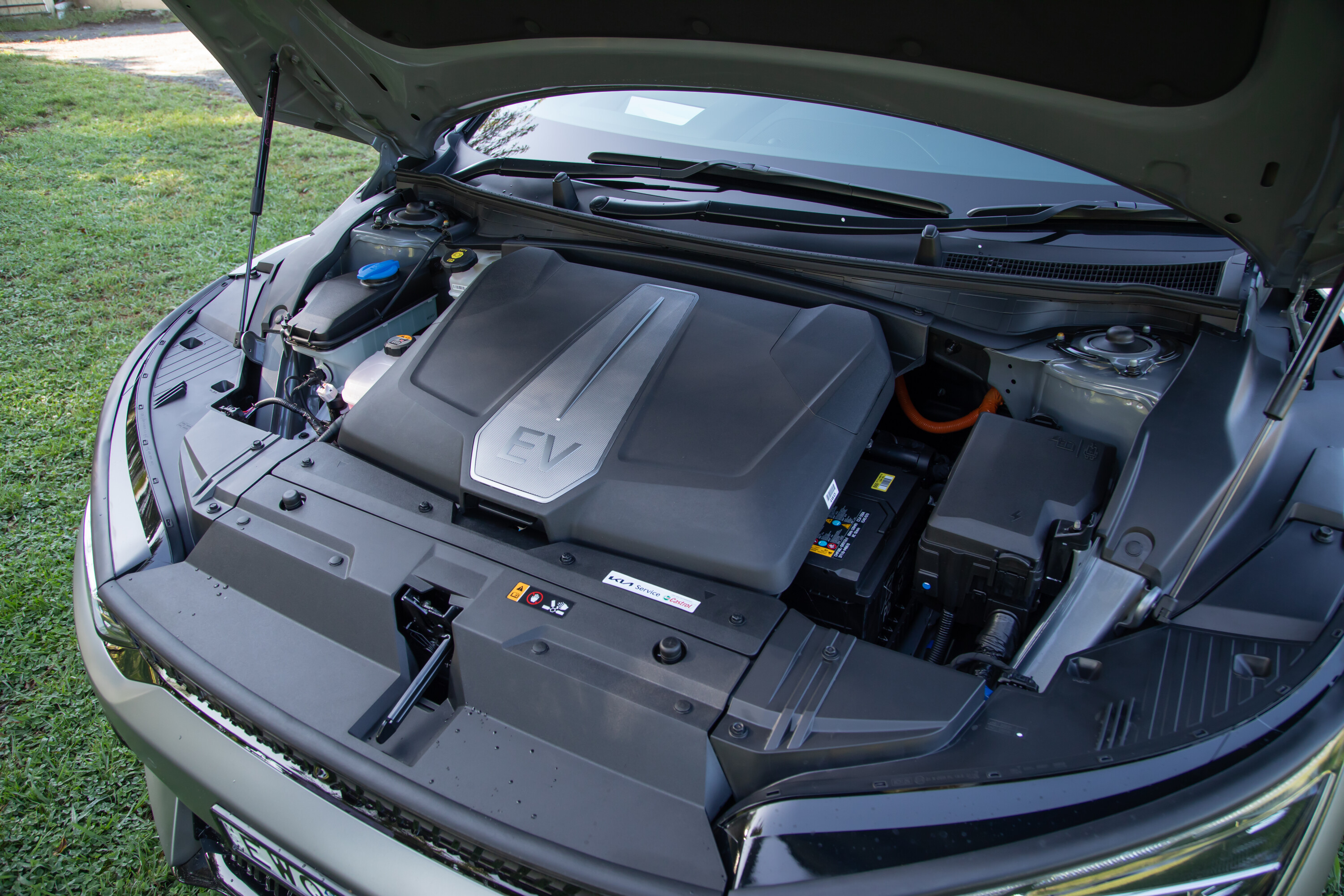
That’s not stellar, but thanks to E-GMP’s 800V electrical architecture, you won’t spend long at the charger (provided you can find an operational 350kW station). The EV6 GT climbs from 10-80 per cent charge in just 18 minutes.
We timed 20-80 per cent at an ultra-rapid Evie 350kW station, and that 47.5kWh charge took the EV6 GT 15 minutes. We observed the EV6 GT’s charging speed peak at 230kW. Hooked up to an 11kW wallbox, the EV6 GT will take seven hours and 20 minutes to go from flat to full.

Australia’s best electric cars for 2023
We’ve tested nearly every EV below six figures in Australia to rank the best on sale today

How safe is it?
The Kia EV6 GT-Line and Air scored five stars in 2022 ANCAP safety testing but because the EV6 GT features different seats, it is not covered by that rating.
However, its sibling’s results should make the GT should be a pretty compelling safety package as they scored 90 per cent in adult occupant protection and 87 per cent in child occupant protection ratings.
The driver assistance features also function well, with adaptive cruise control and lane-keep assist easing long highway slogs.

| Kia EV6 GT safety features: | |
|---|---|
| Lane-trace assist | Adaptive cruise control with stop & go |
| Blind-spot monitoringu00a0 | Rear cross-traffic alert |
| Safe-exit assist | Rear occupant alert |
| Forward AEB (vehicle, pedestrian, cyclist, cross-traffic) | Reverse AEB (low-speed) |
| Driver monitoring | Speed sign assist |

Warranty and running costs
The Kia EV6 GT is covered by a seven-year/unlimited-kilometre warranty in Australia. Kia’s dealer network is expansive in Australia, too.
Servicing is close to a conventional combustion car, requiring maintenance every 12 months or 15,000km at a cost of $1371 over five years/75,000km. Polestar, BYD, and Tesla all offer more hands-off conditions-based servicing models.

VERDICT
The EV6 GT is, well, a bit of an anomaly. It’ll only take you about 380km between fill-ups and misses some of the luxuries the lower trims get.
Wheels readers have also expressed frustration that manufacturers are focusing on expensive, hi-po variants before family transport. Thing is, that’s how technology typically evolves. Boundaries are pushed, and doing so evolves the more affordable products.
And even if the EV6 GT isn’t a rational car, at $100K, it’s a mega-fast pseudo-SUV that’ll give the Porsche Taycan a run for its money – and not just in a straight line. So in a way, it strikes good value.
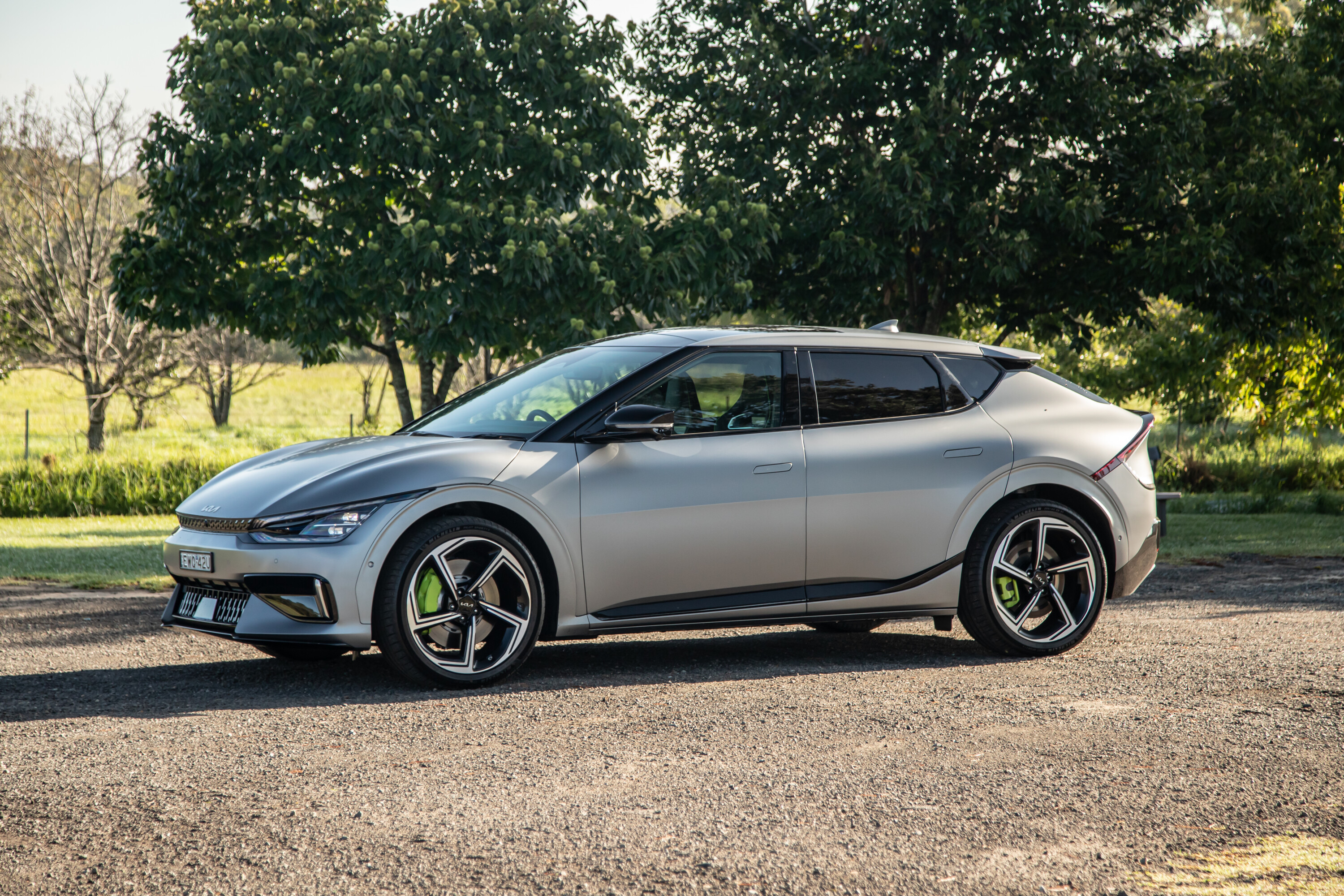
The EV6 GT represents experimentation, a desire to push technology. It’s still an early player in the EV performance car game, but one that’s in the realm of the comfortably off, not just the ultra-rich. Most importantly, it shows the future may still be bright for driving enthusiasts.
If you’re looking to buy an electric vehicle for everyday duties right now, it’s hard to recommend you spend $20K more on this GT than the more-than-adequate GT-Line RWD.
As an exercise in what Kia can achieve, though, the EV6 GT is deserving of praise.
| Kia EV6 GT specifications | |
|---|---|
| Body | 5-door, 5-seat large SUV |
| Boot min / max | 480L / 1260L |
| Drive | all-wheel |
| Powertrain | 77kWh battery; 160kW motor (f), 270kW motor (r) |
| Max power | 430kW |
| Max torque | 740Nm |
| Transmission | single-speed reduction |
| Weight | 2185kg |
| L/W/H/W-B (mm) | 4695/1890/1545/2900 |
| 0-100km/h | 3.5sec (claimed) |
| Price | $99,950 + on-road costs |
| On sale | now |
⚡ More EV stories to help you choose the best car for your needs
Score breakdown
Things we like
- Cross-country pace
- Taycan pace on a Macan budget
- Well-judged sporty ride
- Futuristic appearance
Not so much
- Expensive servicing for an EV
- Restricted real-world driving range
- Fast EVs are a little one-dimensional
We recommend
-
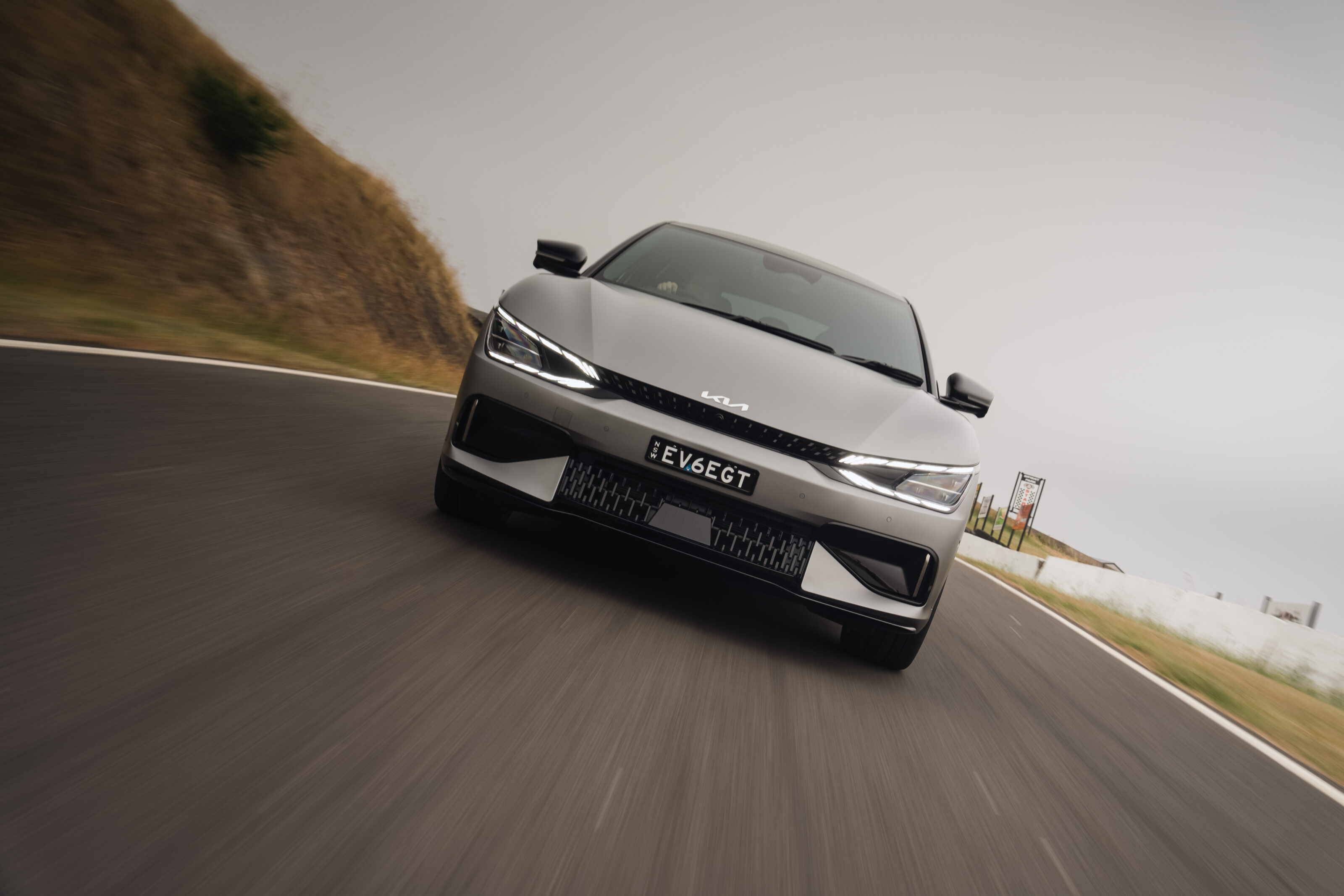 Reviews
Reviews2023 Kia EV6 GT review
The new EV6 GT promises to be as talented on track as it is on road; we hit both in the $100,000, 430kW Kia to find out
-
 News
News2023 Kia EV6 Australian pricing and features
Sporty new EV6 GT variant usurps the flagship position for Kia
-
 News
News2025 New Car Calendar: All the new cars coming to Australia
Take a look at our list of what is expected to launch in Australia in 2025 – plus those we might not see locally just yet






